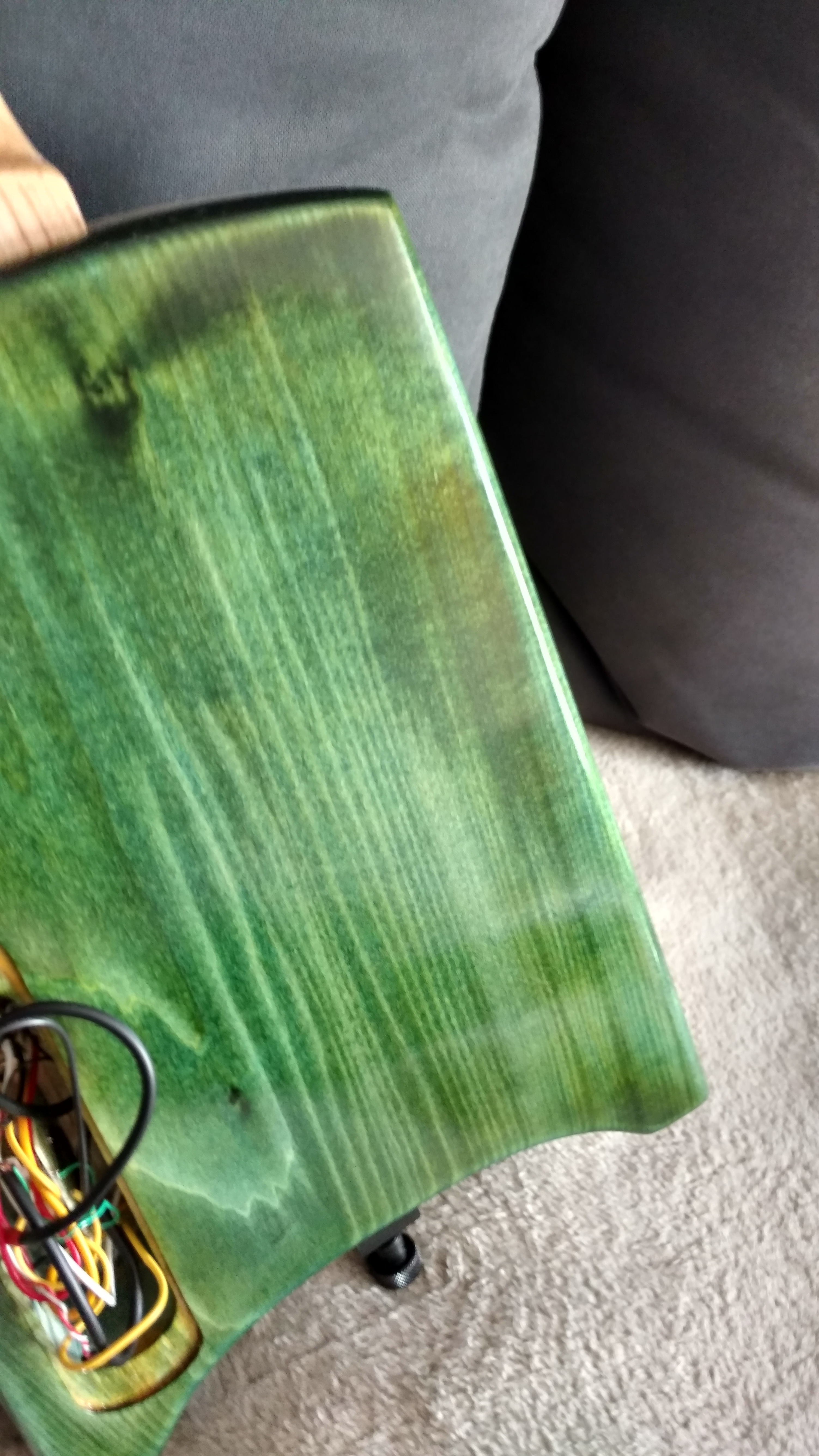Aniline Dyes?
If you're not yet addicted to dying wood using aniline dyes, don't worry. For less than a mere $20, you can be well on your way to the joys and pains of this wonder. I highly recommend checking out Keda Dye for some great, inexpensive dye kits.Problem: Lack of Available Mixing Recipes
I'm fairly new to this myself. So far I've read blogs and watched YouTube just to get myself to a point of passable basic technique. And that has worked well. However, my color choices have been ad hoc. I'll mix up some dye, apply a coat, the next day modify that die, apply another coat, sand down some of the field, modify the dye, apply another coat and so on. And that's fun. You can end up with something you otherwise would not have imagined. Here's an example from my first dye project: the basswood body of a budget Steinberger Spirit clone (excuse the mess of wires).
While definitely not for everyone's taste, I was happy that, with a combination of yellow, light blue, green coats and many coats of Tru Oil, to end up with a finish that I find enjoyable. And that's quite unique for a body wood that is usually painted.
But now I have a project where I have something in mind for the end result. I'm building an inexpensive all low-grade mahogany flying V and despite the imperfections in the wood, I'd like to achieve a color along the lines of this beautiful 80's Aria Pro II Cardinal 350. Conventional advice is the guess and test method: mix up some dye, test it and adjust. And write down what you do as you go in case you need more. That's great advice, but to save others time, why not share what I've written down!
Solution: Dye Recipes and Pictures
My solution to this problem is to get a somewhat nicely figured piece of poplar from Home Depot, chop it into little pieces, use the pieces as testers and write down on them the recipe I'm using. I figured while I'm at it I can start posting online as well just in case it helps someone else get the amounts just right. I sanded them each with 150 grit and I will be wiping them down with isopropyl alcohol to raise the grain shortly before applying the dye.
I chose poplar because it was one of the few dirt cheap pieces of wood I could find on hand that had some nice grain to show. So keep this in mind if you're dying something like mahogany (that's my final target) which may show much darker or maple which will be more stubborn in taking on the dye.
Recipe: Denim Blue
I'm going for a blue that's just light enough to see some grain when standing back but no lighter. Just a bit lighter than my jorts (not pictured here). When using Keda's blue powder remember to keep in mind the special instructions for blue. If mixed with water straight away it will not last more than a workday. Since I do this as a hobby, I have a hard time committing large blocks of time on a project so I mix first with isopropyl and rewarm in a hot water bath before each use.I had initially started with around 2/8 tsp blue dye powder and 1/8 tsp black dye powder. This resulted, even after a few coats, in something that was too light and too dull. So I continued to add more blue dye powder until I arrived at this result.

Note that this is not completely dry. This is on purpose. The lighter areas are how it's going to try. The darker area is what it looks like when wet. This should help you if you're trying to replicate it as you're going to be first looking at it while it's wet. The end result, if I counted correctly:
- 1/8tsp of black dye powder.
- 2/8tsp of blue dye powder.
- 30ml isopropyl alcohol.
- Mix well and wait two minutes.
- 75ml of hot water.
- 3/8tsp more of blue dye powder.
Aniline Will Dye You
I am a bit too clumsy to wear gloves while mixing the dye but of course I wear them while applying it. It is important to do so if you don't want blue hands. Unfortunately, my glove had developed a hole before today's work! I guess I'm going to with a blue finger.
In all seriousness though, while these dies are fairly "non-toxic" compared to most woodworking products, aniline in a high enough dust can be toxic at the "full grams of ingestion" level. More risky perhaps is the fact that this powdered die can easily blow around the room, stick on your feet, you then step on a drip of water in the kitchen and you're leaving blue footprints all over your home. I suggest turning off all fans that blow directly into the area you're working for the short time you have the powders sitting in the open. And if you have one of these, wear it.

I use this while applying sealers and other smelly products that say they'll give me brain damage. And while it's not comfortable, it keeps me from breathing on the dye and either dying my lungs or blowing it all over the room.
I've got a way to go before I'm at a beautiful finish like the one in the link above. So watch for more updates.



This comment has been removed by a blog administrator.
ReplyDelete